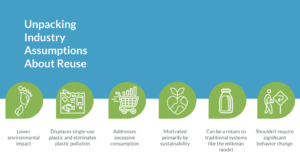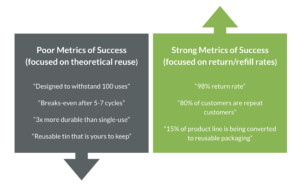April 12, 2022
The Sustainable Packaging Coalition has published a new resource, Guidance for Reusable Packaging, aimed at helping brands and retailers better design and measure effective reusable packaging systems.
Reusable packaging, which includes both refillable and returnable systems, is an opportunity to create a package-product system that is preferable to single-use packaging. Reuse focuses on source reduction as a way to prevent waste. Because these efforts are preferred to end-of-life management, such as recycling, reusable packaging can be a better option for the environment. Yet, many important questions about reuse remain – What is the goal of reusable packaging? When is it the right fit? What does success look like?
The SPC’s new Guidance for Reusable Packaging outlines key considerations for the success, applicability, and sustainability of reusable packaging systems. This guidance is based on observations from interviews with reusable packaging professionals, discussions and panels at industry events, corporate sustainability documents, pilot project communications, and press releases.
The purpose of this new guide is to:
- Synthesize different definitions of reusable packaging, including refillable and returnable packaging, and outline how it compares to single-use packaging
- Pose questions about the role of reusable packaging, including whether it effectively replaces single-use packaging, addresses overconsumption, or reduces the carbon footprint of products
- Consider how consumers interact with reusable packaging and the likelihood that it will be reused in practice
- Suggest important considerations for designing reusable packaging, including when reusable packaging makes the most sense
- Outline best practices for a successful reuse system and ways to measure success
Today, it appears that brands and retailers often operate under a number of assumptions about what reusable packaging should look like, what sustainability goals it can achieve, and how it should be designed. Part 1 of this guide unpacks these assumptions to help brands develop reusable packaging systems that are both more successful and more sustainable in the long run.
You can access the guide here.

Reusable packaging, while not entirely new, is still evolving, particularly for consumer packaged goods, as well as refill and reuse handled primarily by consumers. Some of the assumptions are a reflection of the nascent reuse industry as it grows beyond beverage and secondary packaging contexts to more widespread consumer applications. Furthermore, the nature of these assumptions is expected to change over time, so the guidance offers only a starting point for discussing the true goals and motivations of both consumers and brands.
Part 2 of the guide explores key considerations for designing effective reusable packaging systems, including fit by product category, customization vs. standardization, facilitating reuse in practice, and metrics for success.

We at the Sustainable Packaging Coalition believe that if companies spend time discussing the goals and underlying assumptions of reuse internally and with partners, reusable packaging systems will be more appropriately applied, more successfully deployed, and ultimately, serve as a more sustainable alternative to the single-use systems they replace.
If you’d like to engage with the Sustainable Packaging Coalition on reusable packaging, you can do so by participating in the forthcoming Reusable Packaging Collaborative. To learn more, please contact Lucy Pierce, lucy.pierce@greenblue.org.





